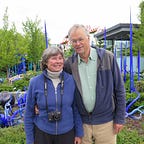Announcing The Social Life Project
“I end, then, in praise of small spaces. For a city, such places are priceless.” — William H. Whyte, The Social Life of Small Urban Spaces
By Fred Kent & Kathy Madden
William “Holly” Whyte was our mentor and our friend. One of his great gifts was showing why some public spaces work and others don’t. With the 1980 publication of The Social Life of Small Urban Spaces and its companion film, people around the world gained a fresh understanding about how to make our cities more livable. He laid the cornerstone for the placemaking movement, which has changed the way public spaces are planned and built.
Still inspired by Holly, we are launching a new effort, we call The Placemaking Fund, which grows out of work we’ve done in 3000 communities around the world over the past 43 years. The Fund is a small not-for-profit” foundation that is undertaking two initial efforts: The Social Life Project, which focuses on how small urban spaces can be the foundation of big change in communities; and PlacemakingX; a global network of leaders who together are accelerating placemaking as a way to create healthy, inclusive, and beloved communities together.
Social Life Success Stories
The goal of The Social Life Project is to showcase examples of great user-friendly spaces and to share the wisdom of people who have created places that deliver all kinds of social, economic, and health benefits. These social life success stories are often right in front of our noses, if we look for them—as Holly Whyte pointed out 30 years ago.
There is no secret for creating great places— the solutions are things that people intuitively understand. The Social Life Project highlights examples from around the world showing how people are making their communities better. We interview the folks who made things happen and share stories, photos and videos of the results. Using a wide array of communications strategies — from social media to exhibitions to public workshops — we bring the simple lessons of placemaking to people everywhere.
Drawing on our long experience of applying placemaking strategies to help communities improve streets, parks, plazas, community centers, waterfronts, libraries and other assets, we demonstrate how “social” spaces naturally bring people together.
Please, Just a Nice Place to Sit
Our first step in this effort is to focus on the basic human need for being comfortable and connected in public spaces which is often overlooked.
Of course good public seating not only gives us a spot to relax and reflect, it is also offers a prime opportunity to casually interact with neighbors. But what we are focussed on is how people st and where. Did they select a particular bench because one was sitting there or not?
Many of the benches widely used today accommodate a single person or at most a couple giving a signal that it is “occupied” to anyone else who might want to sit down.
This longer bench can easily sit three separate groups, increasing the chance for social interaction to occur.
Paris made a revolutionary leap in the social life of seating ten years ago by designing convivial benches like these (above) that can comfortably sit more than a dozen people which maximize opportunities for people to connect. People do not seem to be disturbed by the passionately hugging couple in the photo above…perhaps because Paris is a very comfortable city to both live in and to visit!
This double sided bench, used in many parks in Paris, has a unique dynamic. It is the closest, most convenient seating in the park beside Notre Dame where there is much demand for a place to rest, it is a true specimen of a great bench! Its qualities are that a group can sit either using both sides, it can accommodate another group or one person can just sit by themselves. These are some of the quandries that face designers and planners today.
The need for good seating is too often confused with the desire to use “art as an amenity” and giving people a place to rest seems a minor afterthought. New York’s famous High Line, for instance, has few comfortable seats to sit and some of the most uninviting benches imaginable. They seem to be conceived in a spirit of “look but don’t touch”.
We will explore the use of seating like these examples together with you, as we explore the “Social Life of Small Urban Spaces” around the world.The idea behind this “story” is that seemingly simple things can become the building blocks for great communities and places that can accommodate everyone.
